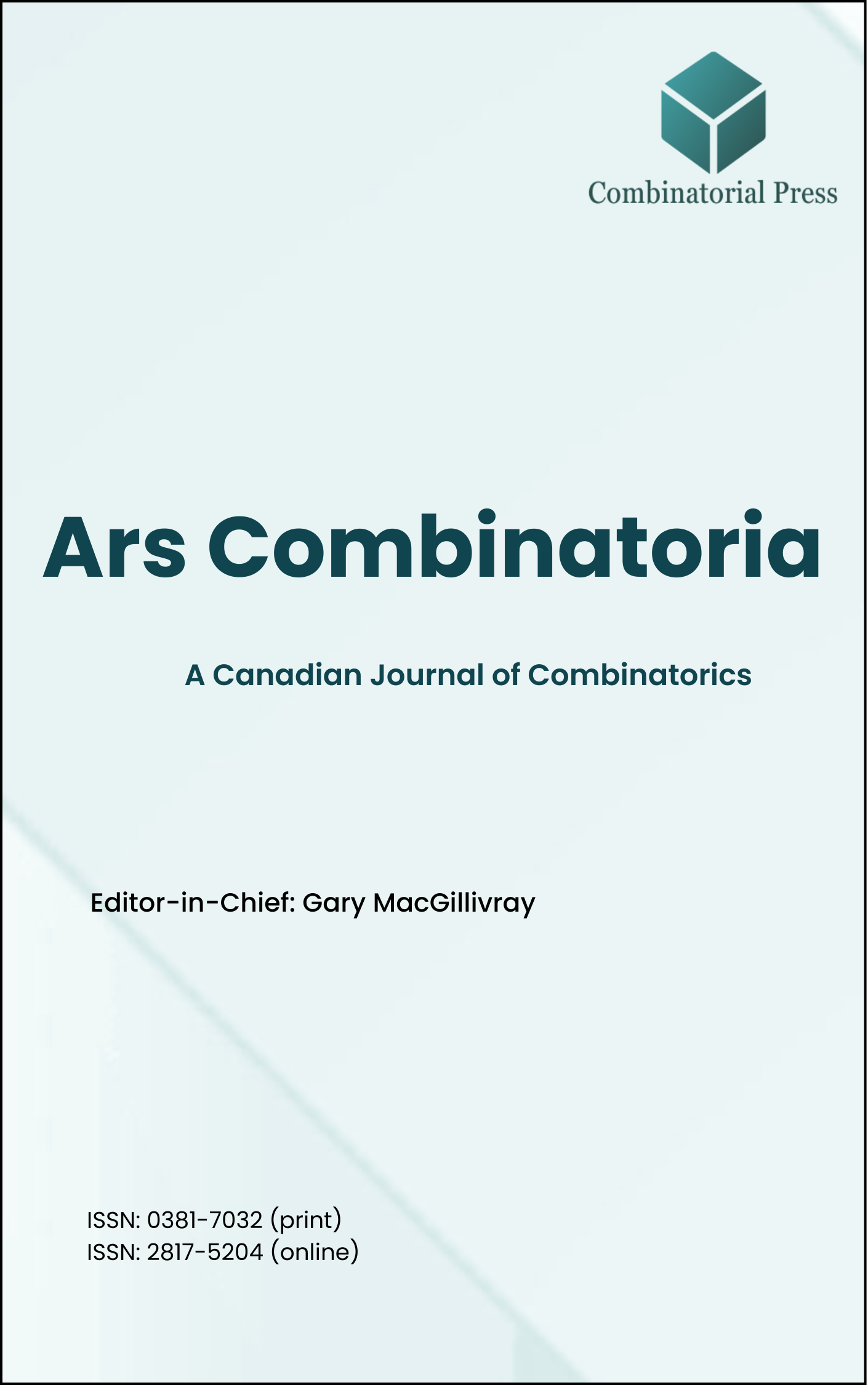
Ars Combinatoria
ISSN 0381-7032 (print), 2817-5204 (online)
Ars Combinatoria is the oldest Canadian Journal of Combinatorics, established in 1976. The journal is dedicated to advancing the field of combinatorial mathematics through the publication of high-quality research papers. From 2024 onward, it publishes four volumes per year in March, June, September and December. Ars Combinatoria has gained recognition and visibility in the academic community and is indexed in renowned databases such as MathSciNet, Zentralblatt, and Scopus. The Scope of the journal includes Graph theory, Design theory, Extremal combinatorics, Enumeration, Algebraic combinatorics, Combinatorial optimization, Ramsey theory, Automorphism groups, Coding theory, Finite geometries, Chemical graph theory but not limited.
Information Menu
- Research article
- Full Text
- Ars Combinatoria
- Volume 035
- Pages: 87-96
- Published: 30/06/1993
We present a permutation group whose orbits classify isomorphism of covering projections of the complete graph with \(4\) vertices. Two structure theorems concerning this group are proved.
- Research article
- Full Text
- Ars Combinatoria
- Volume 035
- Pages: 85
- Published: 30/06/1993
Constructions have been completed which improve the lower bounds for \(R(4,6)\), \(R(5,6)\) and \(R(3,12)\).
- Research article
- Full Text
- Ars Combinatoria
- Volume 035
- Pages: 69-83
- Published: 30/06/1993
Let \(G\) be a graph with minimum degree \(\delta\). For each \(i = 1, 2, \ldots, \delta \), let \(a_i(G)\) (resp. \(\alpha^*_i(G)\)) denote the smallest integer \(k\) such that \(G\) has an \([i, k]\)-factor (resp. a connected \([i, k]\)-factor). Denote by \(G_n\) a complete \(n\)-partite graph. In this paper, we determine the value of \(\alpha_t(G_n)\), and show that \(0 \leq \alpha^*_1(G_n) – \alpha(G_n) \leq 1\) and \(\alpha^*_i(G_n) = a_i(G_n)\) for each \(i = 2, 3, \ldots, \delta\).
- Research article
- Full Text
- Ars Combinatoria
- Volume 035
- Pages: 65-68
- Published: 30/06/1993
An oriented (or ordered) triple means either a Mendelsohn or a transitive triple. An oriented (or ordered) triple system of order \(v\), briefly OTS(\(v\)), is a pair \((V, B)\), where \(V\) is a \(v\)-set and \(B\) is a collection of oriented triples of elements of \(V\), such that every ordered pair of distinct elements of \(V\) belongs to exactly one member of \(B\). It is known that an OTS(\(v\)) exists if and only if \(v \equiv 0, 1 \pmod{3}\). An OTS(\(v\)) is cyclic if it admits an automorphism consisting of a single cycle of length \(v\); an OTS(\(v\)) is rotational if it admits an automorphism consisting of a single fixed point and one cycle of length \(v-1\). In this note we give some constructions of OTS(\(v\))’s which allow to determine the spectrum of cyclic and of rotational OTS(\(v\))’s.
- Research article
- Full Text
- Ars Combinatoria
- Volume 035
- Pages: 33-64
- Published: 30/06/1993
It is shown that the maximal number of pairwise edge disjoint trees of order seven in the complete graph \(K_n\), and the minimum number of trees of order seven, whose union is \(K_n\), are \(\left\lfloor\frac{n(n-1)}{12}\right\rfloor\) and \(\left\lceil\frac{n(n-1)}{12}\right\rceil,n\geq 11\), respectively. (\(\lfloor x\rfloor\) denotes the largest integer not exceeding \(x\) and \(\lceil x\rceil\) the least integer not less than \(x\)).
- Research article
- Full Text
- Ars Combinatoria
- Volume 035
- Pages: 25-32
- Published: 30/06/1993
It is unknown whether or not there exists a \([51, 5, 33; 3]\)-code (meeting the Griesmer bound). The purpose of this paper is to show that there is no \([51, 5, 33; 3]\)-code.
- Research article
- Full Text
- Ars Combinatoria
- Volume 035
- Pages: 15-24
- Published: 31/12/1993
The Hitting Set problem is investigated in relation to restrictions imposed on the cardinality of subsets and the frequency of element occurences in the subsets. It is shown that the Hitting Set subproblem where each subset has cardinality \(C\) for fixed \(C \geq 2\) and the frequency of each element is exactly \(f\) for fixed \(f \geq 3\) remains NP-complete, but the problem becomes polynomial when \(f \leq 2\). The restriction of the Vertex Cover problem to \(f\)-regular graphs for \(f \geq 3\) remains NP-complete.
- Research article
- Full Text
- Ars Combinatoria
- Volume 035
- Pages: 3-14
- Published: 30/06/1993
Hill and Newton showed that there exists a \([20, 6, 12; 3]\)-code, and that the weight distribution of a \([20,5, 12; 3]\)-code is unique. However, it is unknown whether or not a code with these parameters is unique. Recently, Hamada and Helleseth showed that a \([19, 4, 12; 3]\)-code is unique up to equivalence, and characterized this code using a characterization of \(\{21, 6; 3, 3\}\)-minihypers. The purpose of this paper is to show, using the geometrical structure of the \([19, 4, 12; 3]\)-code, that exactly two non-isomorphic \([20, 5, 12; 3]\)-codes exist.
- Research article
- Full Text
- Ars Combinatoria
- Volume 034
- Pages: 313-317
- Published: 31/12/1992
We obtain a new characterization, by a configuration theorem, of the Miquelian geometries among the finite inversive (= Möbius) planes of even order. The main tool used is a characterization due to J. Tits of elliptic ovoids in three-dimensional projective space,
- Research article
- Full Text
- Ars Combinatoria
- Volume 034
- Pages: 344-350
- Published: 31/12/1992
Let \(E_n\) denote the minimum number of edges in a graph that contains every tree with \(n\) edges. This article provides two sets of data concerning \((n+1)\)-vertex graphs with \(E_n\) edges for each \(n \leq 11\): first, a minimum set of trees with \(n\) edges such that all trees with \(n\) edges are contained in such a graph whenever it contains the trees in the minimum set; second, all mutually nonisomorphic graphs that contain all trees with \(n\) edges.





